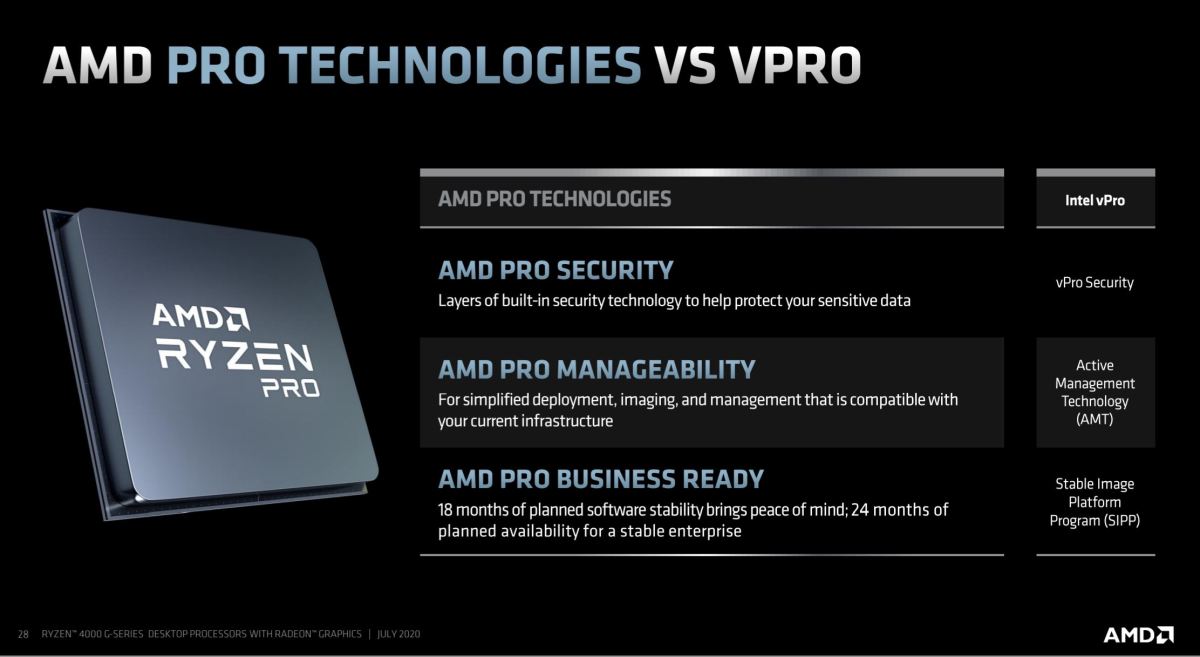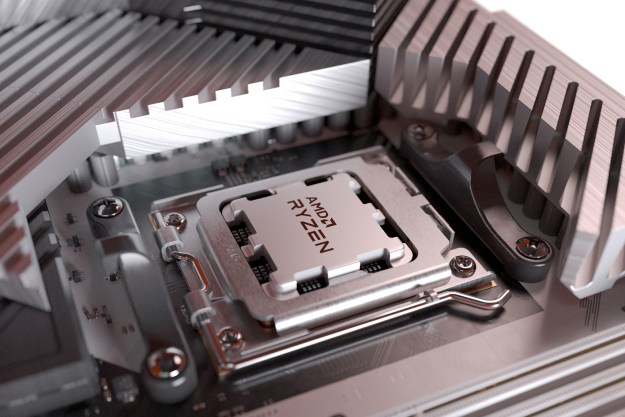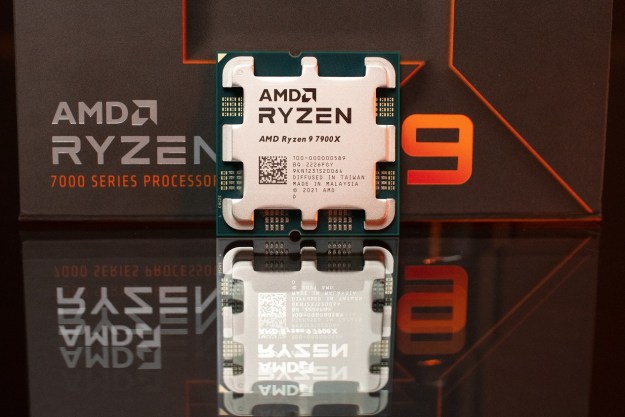In years past, AMD has struggled to convince PC manufacturers to use its chips in high-profile computers. Ryzen 4000 has changed that in the laptop space this year, and now AMD has a solution for prebuilt desktops as well. It’s called Ryzen 4000G, and it’s a series of new processors exclusively sold to PC makers like HP and Lenovo.
Enthusiasts waiting for the next generation of DIY processors might be disappointed, but according to AMD, the market for pr-built desktop PCs is four to five times larger. With Ryzen 4000G, AMD finally has a solution that could win over the support of PC manufacturers, IT professionals, and everyday desktop buyers.
Mobile momentum brought to desktop

Let’s be clear about something upfront. These new Ryzen 4000G chips aren’t meant to be a replacement of the Ryzen 3000 processors.
AMD is continuing to bolster those enthusiast-driven chips with the recent launch of its 3000XT processors. The highly anticipated Zen 3 architecture is still scheduled for later this year, but it hasn’t been announced just yet.
Ryzen 4000G is about filling a gap in its desktop lineup, which should please PC manufacturers. That approach has already won AMD important victories in the laptop arena, with both its 4000H and 4000U chips.
The similarities with AMD’s mobile chips go beyond marketing. Ryzen 4000G uses the same single-die architecture, known as Renoir, and is manufactured with the exact same process. These still use AMD’s Zen 2 cores, which feature the same 43% jump in performance per watt over the prior generation and results in killer efficiency.
These processors also support PCIe 3.0 (but not PCIe 4.0), and unlike AMD’s Ryzen 3000 desktop chips, have built-in integrated Radeon graphics. Ryzen 4000G includes the same discrete Radeon graphics cores featured in mobile chips.
AMD Ryzen 4000G processor options
| Cores/Threads | Cache | Base clock | Boost clock | Radeon graphics cores | Graphics frequency | TDP | |
| AMD Ryzen 7 4700G | 8/16 | 12MB | 3.6GHz | 4.4GHz | 8 | 2.1GHz | 65w |
| AMD Ryzen 5 4600G | 6/8 | 11MB | 3.7GHz | 4.2GHz | 7 | 1.9GHz | 65w |
| AMD Ryzen 3 4300G | 4/8 | 6MB | 3.8GHz | 4.0GHz | 6 | 1.7GHz | 65w |
| AMD Ryzen 7 4700GE | 8/16 | 12MB | 3.1GHz | 4.3GHz | 8 | 2.0GHz | 35w |
| AMD Ryzen 5 4600GE | 6/8 | 11MB | 3.3GHz | 4.2GHz | 7 | 1.9GHz | 35w |
| AMD Ryzen 3 4300GE | 4/8 | 6MB | 3.5GHz | 4.0GHz | 6 | 1.7GHz | 35w |
The Ryzen 7 4700G is the top-end option. It offers eight processor cores, as well as eight Radeon graphics cores. To keep things simple, the Ryzen 5 has six processing cores, and the Ryzen 3 has four, matching Intel’s 10th-gen 65-watt chips spec-for-spec.
For a comparison, the Ryzen 7 4700G and the Intel Core i7-10700 both have eight cores, 16 threads, and even the same-size 12MB cache. The only difference is in frequency. AMD’s offering boasts a 19% higher base clock, while the Core i7-10700’s boost speed is 8% higher.
This clock speed disparity remains the same throughout the entire stack. Intel’s parts do have a slightly large cache in the lower-end options, though. The Core i5-10600 has a 12MB cache, while the Core i3-10300 has an 8MB cache.
AMD has also introduced 35-watt variants of these chips, labeled as the “GE” series. These are meant to fit in smaller form factors, such as compact PCs or all-in-ones. Intel has its own T-series chips, which currently range up to the 10-core Core i9-10900T. AMD doesn’t currently have Ryzen 9 versions of these G-series chips to match Intel.
Radeon graphics stay in the lead
Intel’s 10th-gen desktop chips still use its old 14nm process, with outdated Intel UHD 630 graphics. AMD’s Radeon graphics cores will provide a noticeable uptick in graphics capabilities.
In its own testing, AMD’s Ryzen 7 4700G serves up a 227% performance boost over the Intel Core i7-9700 in 3DMark Time Spy. Though AMD was testing against Intel’s previous generation of graphics, the current 10th-gen integrated graphics have only marginally improved year-over-year.
AMD says the Ryzen 7 4700G can play many 1080p games at Low settings, without the need of a discrete GPU. The company didn’t provide exact frame rates, but in games like Civilization VI, Grand Theft Auto V, and Dota 2, the Ryzen 7 4700G is said to be ahead of its Intel competition.

Playing games at 1080p Low might not sound impressive, but it’s a big step up from what Intel currently offers on desktop. None of these titles are enjoyable on Intel’s current integrated graphics on desktop. Intel’s newer Iris Plus graphics are more competitive with AMD, but they’re currently only available in its Ice Lake-powered laptops.
It should be noted, however, that these graphics demonstrate only a marginal upgrade over the previous generation. In the same 3DMark Time Spy benchmark, the Ryzen 5 4600G is only 6% ahead of the Ryzen 5 3400G. The Ryzen 7 4700G steps it up another 6% from there. That’s not bad, but it’s not going to make a noticeable difference in most games.
AMD says companies like HP or Lenovo will offer configurations that include discrete graphics, though the emphasis will be on the positioning of AMD’s integrated graphics.
But wait, there’s more

AMD also announced a similar set of desktop chips for the commercial side of the market in its Ryzen Pro lineup. These are identical chips to the consumer side, except with an emphasis on security, manageability, and support. These IT features closely match what Intel offers with its vPro processors.
AMD recently launched its Ryzen Threadripper Pro chips, which take a similar approach, except on the workstation front.
Lastly, AMD announced a new set of budget-level Athlon processors to combat Intel’s Pentium and Celeron chips. The Athlon Gold 3150G is a 65-watt, quad-core processor, again with included Radeon graphics. AMD will also offer a 35-watt version, as well as a dual-core Athlon Silver 3050GE.
All the Ryzen 4000G processors are expected to be available at retail beginning in August 2020.
Editors' Recommendations
- AMD makes older PCs more upgradeable once again
- AMD’s new CPU slammed as ‘anti-consumer at best’
- AMD’s upcoming Ryzen 5 5600X3D could completely dethrone Intel in budget builds
- AMD Ryzen 9 7950X3D vs. Intel Core i9-13900K: only one choice for PC gamers
- AMD CES 2023: Ryzen 9 7950X3D, mobile Ryzen 7000, and more



